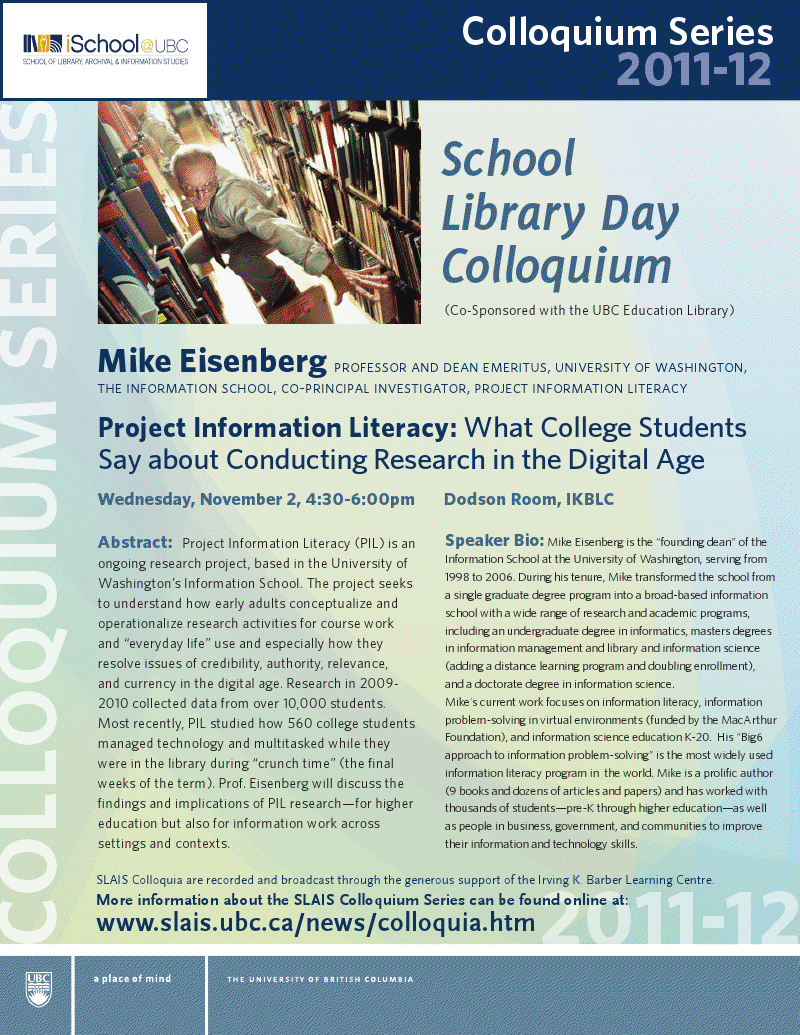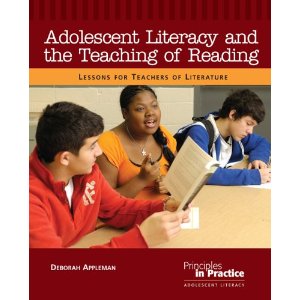Stay up to date on news, events and special features.
Event: Celebrate Learning Week — Celebrate School Libraries
 Our annual School Library Day Colloquium hosted by the UBC Education Library and School of Library Archival and Information Studies will be held on Wednesday, November 2 at 4:30PM.
Our annual School Library Day Colloquium hosted by the UBC Education Library and School of Library Archival and Information Studies will be held on Wednesday, November 2 at 4:30PM.
Speaker: Mike Eisenberg, Professor and Dean Emeritus, The Information School, University of Washington
Topic: Project Information Literacy: What College Students Say about Conducting Research in the Digital Age
Time/Location: Wednesday November 2, 4:30-6:00PM, Dodson Room, IK Barber Learning Centre, UBC campus
Abstract: Project Information Literacy (PIL) is ongoing research project, based in the University of Washington’s Information School. The project seeks to understand how early adults conceptualize and operationalize research activities for course work and “everyday life” use and especially how they resolve issues of credibility, authority, relevance, and currency in the digital age. Research in 2009-2010 collected data from over 10,000 students. Most recently, PIL studied how 560 college students managed technology and multitasked while they were in the library during “crunch time” (the final weeks of the term). Prof. Eisenberg will discuss the findings and implications of PIL research–for higher education but also for information work across settings and contexts.
Speaker Bio: Mike Eisenberg is the “founding dean” of the Information School at the University of Washington, serving from 1998 to 2006. His current work focuses on information literacy, information problem-solving in virtual environments (funded by the MacArthur Foundation), and information science education K-20. His “Big6 approach to information problem-solving” is the most widely used information literacy program in the world. Mike is a prolific author (9 books and dozens of articles and papers) and has worked with thousands of students-pre-K through higher education-as well as people in business, government, and communities to improve their information and technology skills.
SLAIS Colloquia are free and open to the public. These talks are recorded and broadcast through the generous support of the IK Barber Learning Centre.
Schools must distribute report cards (even if they’re mostly blank)
The B.C. government has ordered public schools to prepare and distribute report cards this fall as usual, even though they may contain little more than the student’s name and attendance record due to teacher job action.
In an email to school superintendents, deputy education minister James Gorman said regular report cards are required by law and if teachers won’t prepare them, then principals and vice-principals must do so.
“Report cards are an important educational tool for both parents and students,” Gorman writes. “A report is to be issued to every student regardless of the teachers’ strike, indicating at a minimum, the student’s division, teacher(s), courses, attendance and reports and/or grades for any classes taught by administrators.
“Parents should also be provided contact information to follow up directly with the teacher(s) if they wish to do so and to the extent possible.”
School districts are required to provide three written report cards and two informal reports during the school year, the deputy states. “The duties of principals and superintendents remain unchanged by the teachers’ strike.”
Jameel Aziz, president of the B.C. Principals’ and Vice-Principals’ Association, said report cards for the youngest students will be mostly blank because there are no marks in the early grades and reports are anecdotal, which can’t be drafted without teacher involvement.
In schools where principals and vice-principals also teach classes, marks will be provided as usual.
Public school employers are headed to the B.C. Labour Relatios Board today to seek an order that would compel teachers to prepare report cards.
Over the summer, teachers decided not to write report cards, attend staff meetings or communicate with administrators as part of a job action intended to pressure government to open its purse at the bargaining table. The contract with the B.C. Teachers’ Federation (BCTF) expired June 30 and while talks with the B.C. Public School Employers’ Association continue, there’s been little progress.
To read the entire Vancouver Sun article, click here.
Report gives failing grade to Canada’s education system
Troubling trends in the Canadian education system can be reversed if the country adopts national standards for learning, a report released Tuesday suggests. The Canadian Council on Learning, in its final report before it ceases to exist, says without a national oversight body for education, student achievement will continue to decline and undermine Canada’s economic competitiveness in the years to come.
“Canada is the only country that doesn’t have a national ministry,” says Paul Cappon, the council’s CEO. And the principal reason for this, the report says, is “that our governments have failed to work together to develop the necessary policies and failed to exhibit the required collective political leadership.”
Education falls under the responsibility of provincial governments, with limited federal involvement, but Cappon says that relationship shouldn’t get in the way of what’s good for Canadians, which, he says, is similar to the dynamics of Canadian health care.
“The dysfunctionality of the health-care system costs lives, every week and every month,” says Cappon. “And the dysfunctionality in the education and learning systems costs Canada prosperity, costs opportunities for the young and the not-so-young: so of course, you can only overcome (the divide) if you want to and if there is political will do it.”
The federal-provincial dynamic decreases the quality of education in Canada from early childhood education through to post-secondary schools, aboriginal and adult learning, the council argues. A change is needed to get governments of all levels to work together to avoid further declines in student outcomes, the council says.
General Gordon school to be torn down
A Vancouver school board decision to knock down a 100-year-old heritage school is “extremely disappointing,” but ultimately the fault of the provincial government, says a member of a group that has fought for five years to save the building.
Trustees voted Monday not to ask the provincial government for additional funding to save General Gordon elementary school, saying the heritage value isn’t high enough to warrant the expense.
“It seems such a shame we’ve come into opposition with the trustees who care about public education for the city,” Emily Pickett, a member of General Gordon’s Parent Advisory Committee, said Tuesday.
“We should have been able to join forces with them. I understand they’re trying to be cheap, cheap, cheap but ultimately it’s at the provincial level where the wrongdoing is happening.
“The province will pay $600 million for a retractable roof [for BC Place Stadium] but not $3 million [estimated cost to save one of the heritage facades on the school]. It seems so disproportionate and yet they’re squeezing the public school system to death.”
The Kitsilano school is just one of 48 schools in Vancouver that has to either be replaced or upgraded because they are considered unsafe in the event of an earthquake.
Click here to read the entire Vancouver Sun article.
THIS JUST IN: New Book @ Education Library –> Adolescent Literacy and the Teaching of Reading: Lessons for Teachers of Literature
Adolescent Literacy and the Teaching of Reading: Lessons for Teachers of Literature
Let’s face it: in this age of exploding literacies, all teachers of literature should be teachers of reading. Reading is interpreting; interpreting is reading, which is why it’s more crucial than ever to ensure that our students are able to make meaning as they read. But do we know how to integrate best practices in reading instruction into our classrooms?
In “Adolescent Literacy and the Teaching of Reading: Lessons for Teachers of Literature”, Deborah Appleman dismantles the traditional divide between secondary teachers of literature and teachers of reading and offers a variety of practical ways to teach reading within the context of literature classrooms. As part of NCTE’s Principles in Practice imprint, the book draws on research-based understandings emerging from Adolescent Literacy: An NCTE Policy Research Brief, woven together with practical lessons that will enrich the reading experiences of all students. Using real-world examples from diverse secondary classrooms, Appleman helps literature teachers find answers to the questions they have about teaching reading: How can I help students negotiate the complex texts that they will encounter both in and out of the classroom? What are the best ways to engage whole classes in a variety of texts, both literary and nonliterary? What does it mean to be a struggling reader and how can I support these students? How can I inspire and motivate the male readers in my classes? (via Amazon.com)
Click here to go directly to this item in the UBC Library Catalogue
